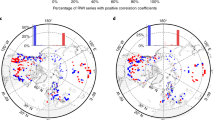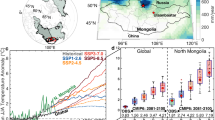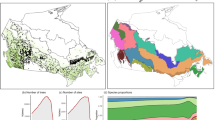Abstract
The sensitivity of forests to near-term warming and associated precipitation shifts remains uncertain1,2,3,4,5,6,7,8,9. Herein, using a 5-year open-air experiment in southern boreal forest, we show divergent responses to modest climate alteration among juveniles of nine co-occurring North American tree species. Warming alone (+1.6 °C or +3.1 °C above ambient temperature) or combined with reduced rainfall increased the juvenile mortality of all species, especially boreal conifers. Species differed in growth responses to warming, ranging from enhanced growth in Acer rubrum and Acer saccharum to severe growth reductions in Abies balsamea, Picea glauca and Pinus strobus. Moreover, treatment-induced changes in both photosynthesis and growth help explain treatment-driven changes in survival. Treatments in which species experienced conditions warmer or drier than at their range margins resulted in the most adverse impacts on growth and survival. Species abundant in southern boreal forests had the largest reductions in growth and survival due to climate manipulations. By contrast, temperate species that experienced little mortality and substantial growth enhancement in response to warming are rare throughout southern boreal forest and unlikely to rapidly expand their density and distribution. Therefore, projected climate change will probably cause regeneration failure of currently dominant southern boreal species and, coupled with their slow replacement by temperate species, lead to tree regeneration shortfalls with potential adverse impacts on the health, diversity and ecosystem services of regional forests.
This is a preview of subscription content, access via your institution
Access options
Access Nature and 54 other Nature Portfolio journals
Get Nature+, our best-value online-access subscription
$29.99 / 30 days
cancel any time
Subscribe to this journal
Receive 51 print issues and online access
$199.00 per year
only $3.90 per issue
Buy this article
- Purchase on Springer Link
- Instant access to full article PDF
Prices may be subject to local taxes which are calculated during checkout





Similar content being viewed by others
Data availability
To create the panels of Extended Data Fig. 8, we used high-resolution gridded data of month-by-month variation in climate (January 1901–December 2020) from the Climatic Research Unit Time Series version 4.05 (CRU TS4.05), available at https://catalogue.ceda.ac.uk/uuid/c26a65020a5e4b80b20018f148556681. We also used species distribution data from the Climate Change Tree Atlas, available at https://www.fs.fed.us/nrs/atlas/tree/ (see refs. 39,40). The data used in the analyses of this work, as well as spreadsheets with the data used in the main-text and Extended Data figures, are available from the Data Repository for University of Minnesota (DRUM) at https://doi.org/10.13020/rv3y-4x19. Source data are provided with this paper.
References
Price, D. T. et al. Anticipating the consequences of climate change for Canada’s boreal forest ecosystems. Environ. Rev. 21, 322–365 (2013).
Wang, Y., Hogg, H. E., Price, T. D., Edwards, J. & Williamson, T. Past and projected future changes in moisture conditions in the Canadian boreal forest. Forestry Chron. 90, 678–691 (2014).
Piao, S. et al. Plant phenology and global climate change: current progresses and challenges. Glob. Chang. Biol. 25, 1922–1940 (2019).
Lu, P., Parker, W. C., Colombo, S. J. & Skeates, D. A. Temperature-induced growing season drought threatens survival and height growth of white spruce in southern Ontario, Canada. Forest Ecol. Manag. 448, 355–363 (2019).
Giorgi, F., Raffaele, F. & Coppola, E. The response of precipitation characteristics to global warming from climate projections. Earth Syst. Dyn. 10, 73–89 (2019).
Sherwood, S. & Fu, Q. A drier future? Science 343, 737–739 (2014).
Seager, R. et al. Dynamical and thermodynamical causes of large-scale changes in the hydrological cycle over North America in response to global warming. J. Clim. 27, 7921–7948 (2014).
Tam, B. Y. et al. CMIP5 drought projections in Canada based on the Standardized Precipitation Evapotranspiration Index. Can. Water Resour. J. 44, 90–107 (2019).
Wu, Z., Dijkstra, P., Koch, G. W., Peñuelas, J. & Hungate, B. A. Responses of terrestrial ecosystems to temperature and precipitation change: a meta-analysis of experimental manipulation. Glob. Chang. Biol. 17, 927–942 (2011).
Zhao, J., Hartmann, H., Trumbore, S., Ziegler, W. & Zhang, Y. High temperature causes negative whole-plant carbon balance under mild drought. New Phytol. 200, 330–339 (2013).
Reich, P. B. et al. Effects of climate warming on photosynthesis in boreal tree species depend on soil moisture. Nature 562, 263–267 (2018).
Hansen, W. D. & Turner, M. G. Origins of abrupt change? Postfire subalpine conifer regeneration declines nonlinearly with warming and drying. Ecol. Monogr. 89, e01340 (2019).
Girardin, M. P. et al. No growth stimulation of Canada’s boreal forest under half-century of combined warming and CO2 fertilization. Proc. Natl Acad. Sci. USA 113, E8406–E8414 (2016).
Sulla-Menashe, D., Woodcock, C. E. & Friedl, M. A. Canadian boreal forest greening and browning trends: an analysis of biogeographic patterns and the relative roles of disturbance versus climate drivers. Environ. Res. Lett. 13, 014007 (2018).
Peng, C. et al. A drought-induced pervasive increase in tree mortality across Canada’s boreal forests. Nat. Clim. Chang. 1, 467–471 (2011).
Ma, Z. et al. Regional drought-induced reduction in the biomass carbon sink of Canada’s boreal forests. Proc. Natl Acad. Sci. USA 109, 2423–2427 (2012).
Ju, J. & Masek, J. G. The vegetation greenness trend in Canada and US Alaska from 1984–2012 Landsat data. Remote Sens. Environ. 176, 1–16 (2016).
D’Orangeville, L. et al. Beneficial effects of climate warming on boreal tree growth may be transitory. Nat. Commun. 9, 3213 (2018).
Johnstone, J. F. et al. Changing disturbance regimes, ecological memory and forest resilience. Front. Ecol. Environ. 14, 369–378 (2016).
Rodgers, V. L., Smith, N. G., Hoeppner, S. S. & Dukes, J. S. Warming increases the sensitivity of seedling growth capacity to rainfall in six temperate deciduous tree species. AoB Plants 10, ply003 (2018).
Moyes, A. B., Castanha, C., Germino, M. J. & Kueppers, L. M. Warming and the dependence of limber pine (Pinus flexilis) establishment on summer soil moisture within and above its current elevation range. Oecologia 171, 271–282 (2013).
Balducci, L. et al. How do drought and warming influence survival and wood traits of Picea mariana saplings? J. Exp. Bot. 66, 377–389 (2015).
Reich, P. B. et al. Geographic range predicts photosynthetic and growth response to warming in co-occurring tree species. Nat. Clim. Chang. 5, 148–152 (2015).
Coursolle, C. et al. Moving towards carbon neutrality: CO2 exchange of a black spruce forest ecosystem during the first 10 years of recovery after harvest. Can. J. Forest Res. 42, 1908–1918 (2012).
Khomik, M., Williams, C. A., Vanderhoof, M. K., MacLean, R. G. & Dillen, S. Y. On the causes of rising gross ecosystem productivity in a regenerating clearcut environment: leaf area vs. species composition. Tree Physiol. 34, 686–700 (2014).
Engelbrecht, B. et al. Drought sensitivity shapes species distribution patterns in tropical forests. Nature 447, 80–82 (2007).
Friedman, S. K. & Reich, P. B. Regional legacies of logging: departure from presettlement forest conditions in northern Minnesota. Ecol. Appl. 15, 726–744 (2005).
Burrill, E. A. et al. The Forest Inventory and Analysis Database: Database Description and User Guide Version 9.0.1 for Phase 2 https://www.fia.fs.fed.us/library/database-documentation/ (Forest Service, US Department of Agriculture, 2022).
Cumming, S. G. et al. A gap analysis of tree species representation in the protected areas of the Canadian boreal forest: applying a new assemblage of digital Forest Resource Inventory data. Can. J. Forest Res. 45, 163–173 (2015).
Brook, B. W., Ellis, E. C., Perring, M. P., Mackay, A. W. & Blomqvist, L. Does the terrestrial biosphere have planetary tipping points? Trends Ecol. Evol. 28, 396–401 (2013).
Reyer, C. P. O. et al. Forest resilience and tipping points at different spatio-temporal scales: approaches and challenges. J. Ecol. 103, 5–15 (2015).
Stralberg, D. et al. Climate‐change refugia in boreal North America: what, where, and for how long? Front. Ecol. Environ. 18, 261–270 (2020).
Etterson, J. R., Cornett, M. W., White, M. A. & Kavajecz, L. C. Assisted migration across fixed seed zones detects adaptation lags in two major North American tree species. Ecol. Appl. 30, e02092 (2020).
Solarik, K. A., Cazelles, K., Messier, C., Bergeron, Y. & Gravel, D. Priority effects will impede range shifts of temperate tree species into the boreal forest. J. Ecol. 108, 1155–1173 (2020).
Stefanski, A., Bermudez, R., Sendall, K. M., Montgomery, R. A. & Reich, P. B. Surprising lack of sensitivity of biochemical limitation of photosynthesis of nine tree species to open‐air experimental warming and reduced rainfall in a southern boreal forest. Glob. Chang. Biol. 26, 746–759 (2020).
Perala, D. A. How endemic injuries affect early growth of aspen suckers. Can. J. Forest Res. 14, 755–762 (1984).
Buckman, R. E. Effects of prescribed burning on hazel in Minnesota. Ecology 45, 626–629 (1964).
Harvey, B. D. & Bergeron, Y. Site patterns of natural regeneration following clear-cutting in northwestern Quebec. Can. J. Forest Res. 19, 1458–1469 (1989).
Harris, I. et al. Version 4 of the CRU TS monthly high-resolution gridded multivariate climate dataset. Sci. Data 7, 109 (2020).
Peters, M. P., Prasad, A. M., Matthews, S. N. & Iverson, L. R. Climate Change Tree Atlas, Version 4 https://www.nrs.fs.fed.us/atlas (Northern Research Station and Northern Institute of Applied Climate Science, US Forest Service, 2020)
Niinemets, Ü. & Valladares, F. Tolerance to shade, drought, and waterlogging of temperate Northern Hemisphere trees and shrubs. Ecol. Monogr. 76, 521–547 (2006).
Acknowledgements
We thank the many field assistants who were involved in implementing and maintaining the experimental facility, the experimental planting and the measurements presented in this paper. This research was supported by the US Department of Energy, Office of Science, and Office of Biological and Environmental Research award number DE‐FG02‐07ER64456; Minnesota Agricultural Experiment Station MN-42-030 and MN-42-060; the College of Food, Agricultural and Natural Resources Sciences and Wilderness Research Foundation, University of Minnesota; and the National Science Foundation, Biological Integration Institutes grant NSF-DBI-2021898.
Author information
Authors and Affiliations
Contributions
P.B.R., R.A.M., S.E.H. and R.L.R. conceived and designed the original experiment. A.S., R.L.R., K.E.R. and R.B. collectively implemented the experiment; supervised or performed acquisition of all tree growth and survival data, as well as associated temperature and rainfall data; and curated all data. P.B.R. developed the idea for this study, carried out all analyses, constructed the figures and tables with assistance from R.B. and wrote the first draft. All authors contributed to the interpretation of the results and were involved in writing and editing subsequent drafts. P.B.R. and R.A.M. were responsible for acquiring the funding for the project, and P.B.R. was responsible for all project supervision and administration.
Corresponding author
Ethics declarations
Competing interests
The authors declare no competing interests.
Peer review
Peer review information
Nature thanks Arun Bose and the other, anonymous, reviewer(s) for their contribution to the peer review of this work. Peer reviewer reports are available.
Additional information
Publisher’s note Springer Nature remains neutral with regard to jurisdictional claims in published maps and institutional affiliations.
Extended data figures and tables
Extended Data Fig. 1 Percent of individuals of the cohorts planted in 2012 and 2013 surviving over time, by species, warming, and rainfall treatments.
Extended Data Fig. 2 Growth (mean stem biomass per plant) over time by species and warming and rainfall treatments for plants of the 2012 and 2013 cohorts.
The cohorts were planted in spring, and censused in the fall of the same year and fall of each subsequent year. Each point represents the mean stem biomass per plant (± SE) of the survivors. Sample sizes shown in Extended Data Table 3.
Extended Data Fig. 3 Warming response of biomass growth in relation to warming response of survival.
Relationship among species of the percent change in cumulative stem biomass growth in + 3.1 °C warming (relative to biomass in ambient temperatures) to the percent change in cumulative survival in + 3.1 °C warming (relative to survival in ambient temperatures) for years 2013–2016 for plants in ambient rainfall treatments. Each line represents the regression for a different year; the fits are not intended to convey a biological function but to illustrate the association of growth and survival. The pointed–gray horizontal line represents the average growth for ambient temperature plants considered as reference for growth. Relationships were similar (i.e., growth and survival responses compared to ambient grown plants were positively associated) for plants in low rainfall treatment and for plants in the intermediate warming treatment. Sample sizes shown in Extended Data Table 3.
Extended Data Fig. 4 Relationship between warming response and species latitude.
Relationships between the percent change in cumulative survival or cumulative biomass growth in + 3.1 °C treatment relative to ambient temperature treatment for plants in ambient rainfall treatment (as in Extended Data Fig. 3) and latitude for years 2013–2016. In each row, different symbols (corresponding to those used in Extended Data Fig. 3) represent the different years. Each point within a panel represents a species according to their geographic center of latitudinal distribution in central North America23. From left to right: Acer rubrum, Quercus rubra, Quercus macrocarpa, Acer saccharum, Pinus strobus, Betula papyrifera, Abies balsamea, Pinus banksiana, and Picea glauca. Each line represents the regression for a different year; the fits are not intended to convey a biological function but to illustrate the association of growth or survival response to warming with species distributions. The pointed–gray line represents the average growth for ambient temperature plants considered as reference for growth. Relationships were similar (i.e., growth and survival responses compared to ambient grown plants were both associated with species distributions) for plants in low rainfall treatment and for plants in the intermediate warming treatment. Sample sizes shown in Extended Data Table 3.
Extended Data Fig. 5 Relationship between photosynthetic response to warming and species stomatal sensitivity to soil moisture.
Relationships between change in net photosynthesis due to climate treatments and (left) the sensitivity of stomatal conductance to soil moisture for nine species in two different rainfall regimes and (right) the sensitivity of stomatal limitation to VWC for nine species in two different rainfall regimes. For both x–axes we use the slope of the relevant metric versus VWC. For net photosynthesis measured on plants in + 3.1 °C warming in both ambient and reduced rainfall, the effects are characterized as the change relative to plants in the ambient temperature–ambient rainfall plots. Lines and 95% confidence intervals shown for either linear correlation or logarithmic fits. Sample sizes for the different species and treatments showing the values for ambient rainfall followed by the reduced rainfall treatment: A. balsamea (85, 65), A. rubrum (160, 156), A. saccharum (164, 160), B. papyrifera (156, 146), P. glauca (138, 128), P. banksiana (119, 115), P. strobus (136, 136), Q. macrocarpa (160, 162) and Q. rubra (166, 166).
Extended Data Fig. 6 Stem mass in relation to climate treatments.
Stem mass per unit ground area (combines survival and growth) by species and warming and reduced rainfall treatments in 2016. Error bars show ± SE calculated from the data aggregated by plot (n = 6). Sample sizes shown in Extended Data Table 3.
Extended Data Fig. 7 Warming response in relation to species abundances.
Effects of warming and rainfall treatments on different response metrics in relation to species relative abundance in northeastern Minnesota, USA. For growth, survival and photosynthesis measured on plants in + 1.6 °C, + 3.1 °C warming in both ambient and reduced rainfall, the effects are characterized as the change relative to plants in the ambient temperature, ambient rainfall plots. Total number of individuals per species in 2019 is across all U.S. FIA plots in the MNDNR Ecological Classification System Zone 212 (which covers most of northeastern Minnesota). The sample sizes are the same as described in the Fig. 3 for the middle and bottom row panels.
Extended Data Fig. 8 Location of average experimental treatment climate in relation to the climate range of each species.
Each panel corresponds to one experimental species and the contour lines contain the average May 1st to September 30th precipitation and temperature conditions of the 95% central points extracted from the 0.5º pixels climate dataset of the mid–continental range39 (88º W–98º W) of North America that overlaps with the range of each species shown in the North America atlas40. Each contour represents the average of 30 years and they are calculated for every period from the most recent (1991–2020) to as far back as 1941–1970. The data points show the mean 5–year average May 1st–September 30th rainfall and temperature for each climate treatment at each site.
Supplementary information
Source data
Rights and permissions
Springer Nature or its licensor holds exclusive rights to this article under a publishing agreement with the author(s) or other rightsholder(s); author self-archiving of the accepted manuscript version of this article is solely governed by the terms of such publishing agreement and applicable law.
About this article
Cite this article
Reich, P.B., Bermudez, R., Montgomery, R.A. et al. Even modest climate change may lead to major transitions in boreal forests. Nature 608, 540–545 (2022). https://doi.org/10.1038/s41586-022-05076-3
Received:
Accepted:
Published:
Issue Date:
DOI: https://doi.org/10.1038/s41586-022-05076-3
This article is cited by
-
Response mechanism of carbon metabolism of Pinus massoniana to gradient high temperature and drought stress
BMC Genomics (2024)
-
Drought response of the boreal forest carbon sink is driven by understorey–tree composition
Nature Geoscience (2024)
-
More than 17,000 tree species are at risk from rapid global change
Nature Communications (2024)
-
Elevated CO2 levels promote both carbon and nitrogen cycling in global forests
Nature Climate Change (2024)
-
Restricted plant diversity limits carbon recapture after wildfire in warming boreal forests
Communications Earth & Environment (2024)
Comments
By submitting a comment you agree to abide by our Terms and Community Guidelines. If you find something abusive or that does not comply with our terms or guidelines please flag it as inappropriate.



